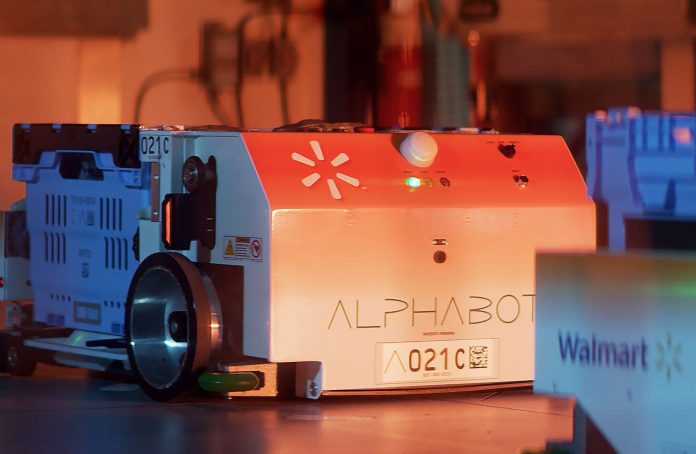Walmart has put automated pick-and-pack robots to work at a so-called ‘supercenter’ in Salem, New Hampshire.
The new system, called Alphabot, is live in a 20,000-square-foot warehouse-style extension at its Salem superstore, which has been opened as a grocery pickup point with drive-thru lanes for customers.
It sees autonomous carts retrieve ambient, refrigerated and frozen items ordered for online grocery from the racking system inside the warehouse, and deliver the products to workstations, where Walmart staff check, bag and deliver them for final order.
The Alphabot system, designed for Walmart by startup company Alert Innovation, replaces manual back-room work of staff to retrieve items from the warehouse. Instead, as it stands, they are only required to pick fresh produce by hand, and to bag orders as they arrive at pick-up points.
The autonomous carts operate on three axes of motion, moving horizontally and vertically without lifts or conveyors, for a more flexible system than in most fulfillment centres and warehouses. The system also means fewer space constraints around storage.
Brian Roth, senior manager of pickup automation and digital operations at Walmart, said: “This will lower dispense times, increase accuracy and improve the entirety of online grocery. And it will help free associates to focus on service and selling, while the technology handles the more mundane, repeatable tasks.”
The system also shares and learns order information, to make stock ordering and fulfilment more intelligent. Roth said: “We never want to tell an online customer they can’t have an item. We’ll be able to look at datasets and fairly say ‘these two brands of pasta are typically bought together,’ or ‘here’s an item a consumer buys often,’ and use that information to make more informed substitutions.”
The Salem setup has been in pilot mode since mid-2019. Walmart said the system will be rolled out across stores, pending closer studies and tweaks. Roth said: “This is going to be a transformative impact to Walmart’s supply chain. Alphabot is what we think of as micro-fulfillment – an inventive merger of e-commerce and brick and mortar methods.”
Walmart has been using technology to offer micro-fulfillment services, to complement traditional big-shop visits. The strategy is evident at its local Neighborhood Market stores. It has just opened a Neighborhood Market in Coral Way, in Florida, with drive-thru order collections, doorstep (and direct-to-fridge) deliveries,and various in-store queue-jumping technologies.
The company has been using analytics-based technologies – presented as artificial intelligence (AI) – at a Walmart Neighborhood Market in Levittown, in New York, which has been rebranded internally as the company’s Intelligent Retail Lab (IRL).
The company is using an array of sensors, cameras and processors in the Levittown store to gather data about product quality and availability, and to replenish stock accordingly.
“While the application of AI in e-commerce is now table stakes, there haven’t been many physical explorations of its potential… Customers can be confident about products being there, about the freshness of produce and meat. Those are the types of things that AI can really help with,” the company has stated.
Meanwhile, Walmart in Canada has launched a blockchain-based freight and payment network for 70 third-party trucking companies carrying goods for 400-odd Walmart stores in Canada.
The new platform, designed with Toronto-based blockchain developer DLT Labs, uses distributed ledger technology to track deliveries, verify transactions, and automate payments and reconciliation for members of Walmart’s supply chain in Canada, serving around 400 stores in the country.

